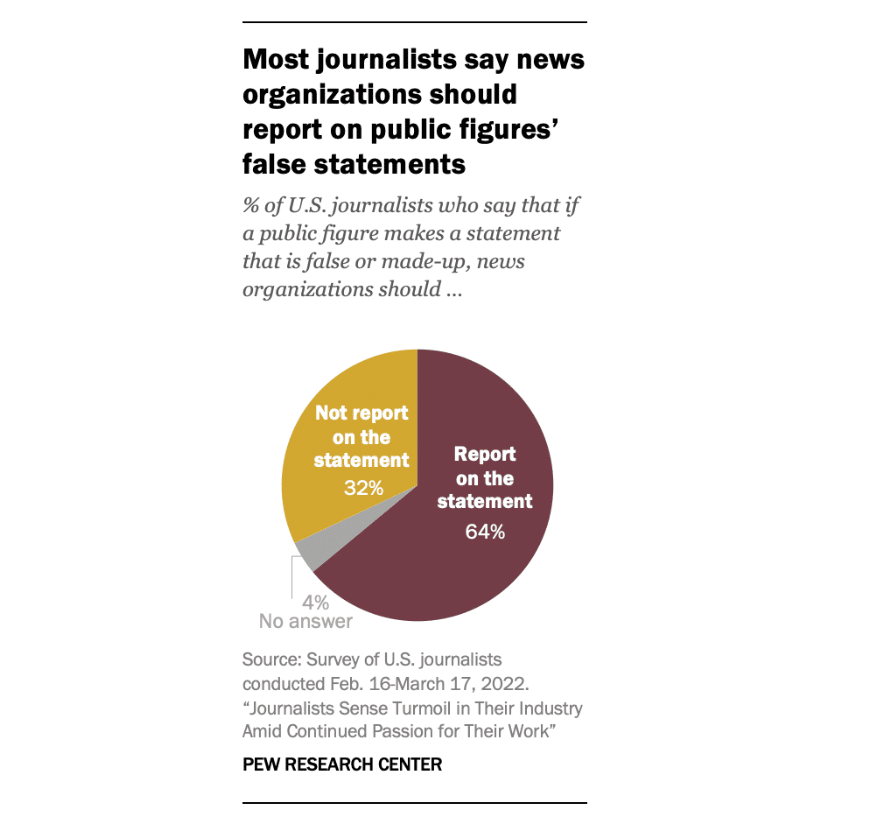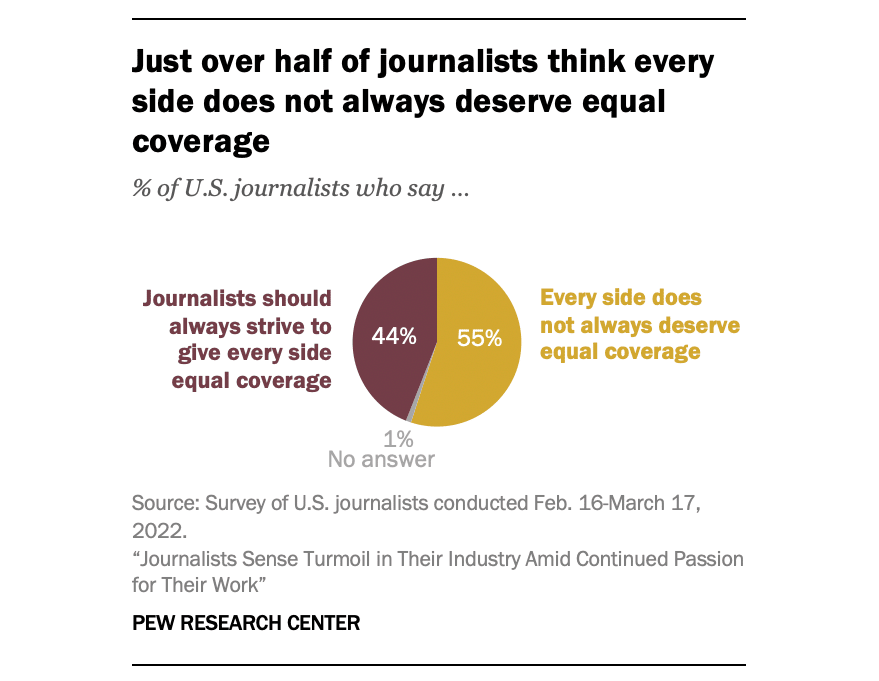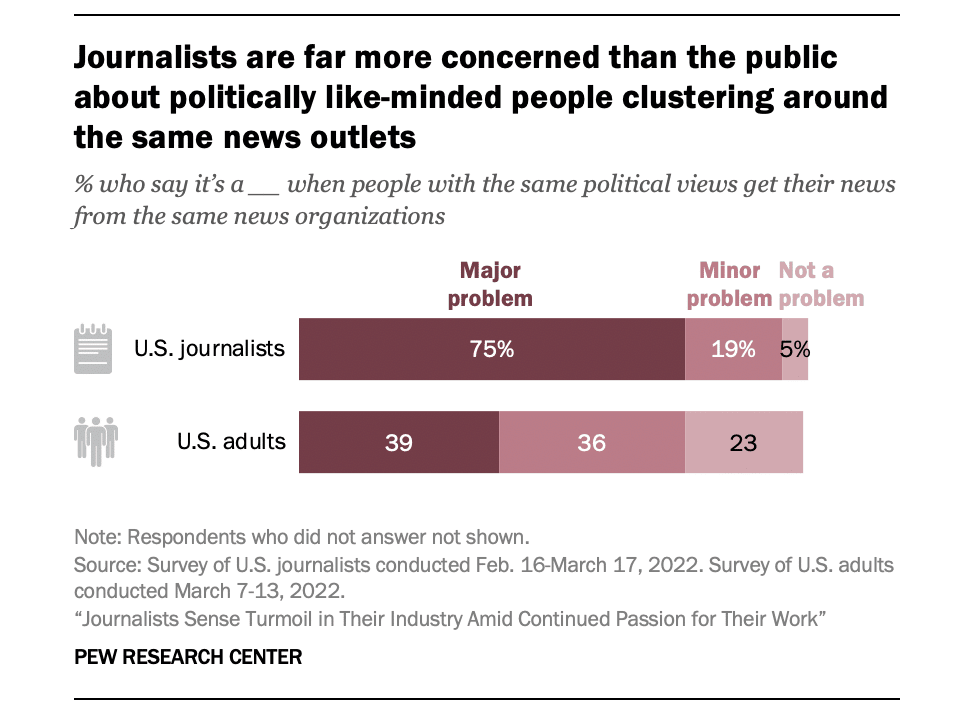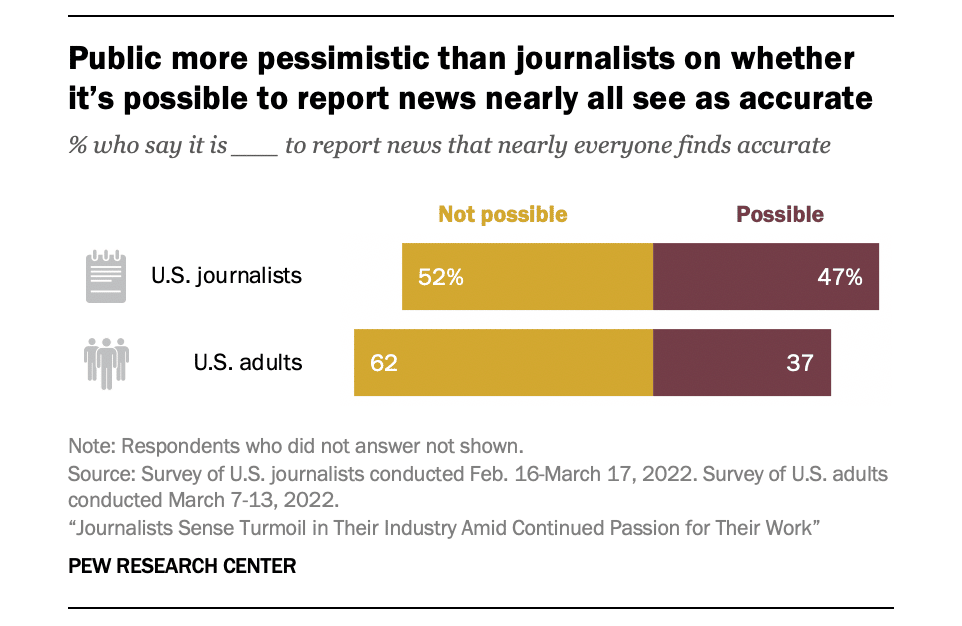Journalism in America has been in a state of turmoil for decades, stemming from the economic upheaval of the digital age to the rise of political polarization and the COVID-19 pandemic. New research from Pew Research Center shares journalists’ perspectives about the news industry they work in and their relationship with the public they serve.
While journalists recognize the many challenges facing their industry, the Center’s survey of nearly 12,000 working U.S.-based journalists finds that they continue to express a high degree of satisfaction in their jobs: Seven-in-ten journalists say they are very or somewhat satisfied with their job, and 77 percent say they would pursue a career in journalism again.
At the same time, when asked to describe their industry in a single word, nearly three-quarters of respondents (72 percent) use a word with negative connotations; the most common are words that relate to “struggling” and “chaos.” The report also identifies several specific areas of concern for journalists, including the future of press freedom, widespread misinformation, and politically like-minded people getting news from the same sources.
The report has two key components. The central one is a Center survey of 11,889 U.S.-based journalists currently working in the news industry, conducted online between Feb. 16 and March 17, 2022. (For this study, journalists are defined as individuals who create, edit or report original news stories across a wide range of reporting areas and beats.) The report also includes findings from two separate surveys of U.S. adults on Pew Research Center’s American Trends Panel that measure how views and attitudes of the American public compare with those of journalists.
Among key findings from the report:
Just 14 percent of journalists surveyed say they think the U.S. public has a great deal or a fair amount of trust in the information it gets from news organizations these days
Most believe that Americans as a whole have some trust (44 percent) or little to no trust (42 percent). When a similar question was posed to the American public however, 29 percent of U.S. adults say they have at least a fair amount of trust in the information they get from news outlets, while 27 percent say they have some trust and 44 percent have little to no trust.
About seven-in-ten journalists (71 percent) say made-up news and information is a very big problem for the country, higher than the 50 percent of U.S. adults who say the same
And while 71 percent of journalists are extremely or very confident in their ability to recognize false information when working on a story, a smaller 43 percent say news organizations do a good job managing or correcting misinformation.
- When asked about the best newsroom approach to coverage of a false statement made by a public figure, far more journalists say news organizations should “report on the statement because it is important for the public to know about” (64 percent) than say they should “not report on the statement because it gives attention to the falsehoods and the public figure” (32 percent).
- In a separate question asked only of reporting journalists (see methodology for who falls into this category), about a quarter of reporting journalists (26 percent) say they have unknowingly reported on a story that was later found to contain false information.
Three-quarters of journalists say that they largely agree on the basic facts of the news, but about half (52 percent) say it is not possible to report news that nearly everyone finds accurate
An even greater share of the U.S. public overall (62 percent) says it is not possible to report news that is universally accepted as accurate.
Looking forward, journalists express great concern about the future of press freedoms in the U.S.
More than half of journalists surveyed (57 percent) say they are extremely or very concerned about the prospect of press restrictions being imposed in the U.S. About a quarter (23 percent) are somewhat concerned, while just one-in-five express low levels of concern about this. Older journalists are more likely to be extremely or very concerned about it—68 percent of those 65 and older say this, compared with 42 percent of those ages 18 to 29.
While there is no consensus among journalists about whether opposing views always warrant equal coverage, they express wide support for keeping their personal views out of their reporting
- A little over half of journalists surveyed (55 percent) say that in reporting the news, every side does not always deserve equal coverage, greater than the share who say journalists should always strive to give every side equal coverage (44 percent). In contrast, the U.S. public largely says that journalists should always strive to give equal coverage (76 percent).
- Roughly eight-in-ten journalists (82 percent) say journalists should keep their views out of what they report on, although there is less agreement among journalists over whether journalists meet this standard. Just over half (55 percent) think journalists largely are able to keep their views out of their reporting, while 43 percent say they are often unable to.
Journalists express deep concerns over political sorting in the public’s news consumption habits
Three-quarters of those surveyed say it is a major problem when people with similar political views get their news from the same news organizations. The American public, however, appears much less worried: Roughly four-in-ten U.S. adults (39 percent) say this is a major problem.
Journalists see many ways that social media helps them do their jobs, but overall they see it as a negative force on the industry
Among journalists who use social media for their work, 87 percent say it has a very or somewhat positive impact on promoting news stories, and 79 percent say it helps them connect with their audience and find sources for their news stories. At the same time, however, two-thirds of all journalists surveyed (67 percent) say social media has a very or somewhat negative impact on the state of journalism as a whole. Just 18 percent say social media has a positive impact on the news industry.
Roughly four-in-ten journalists (42 percent) say they have been harassed or threatened by someone outside their own organization in the past year
Within this group, the vast majority (78 percent) say that harassment came through social media at least once.
Although two-thirds (67 percent) say their organization has achieved sufficient gender diversity, about half as many (32 percent) say it has reached sufficient racial and ethnic diversity
And fewer than half of respondents (42 percent) say addressing issues of diversity and inclusion is a “major priority” for their newsroom. Relatedly, about half (48 percent) have participated in a formal training session or meeting on diversity in their workplace in the past year, and 40 percent have done so on how to cover issues of diversity and inclusion.
The survey sought to gauge the financial standing of journalists and the economics of the organizations they work for, finding both optimism and concern.
- About four-in-ten journalists surveyed (41 percent) say they received a salary increase in the past year. The greatest portion (50 percent) say their salary has stayed the same, while far fewer (7 percent) experienced a pay cut.
- Looking at news organizations more broadly, journalists are somewhat more likely to say their news organization expanded (33 percent) than cut back (22 percent) in the past year, with a lack of change again being most common (46 percent).
The margin of sampling error for the survey of 11,889 U.S.-based journalists is plus or minus 1.0 percentage points. The first of two surveys of the U.S. public was conducted Feb. 7-13, 2022, among 9,388 adults, with a margin of sampling error for the full sample of respondents of plus or minus 1.6 points. The second of these was conducted March 7-13, 2022, among 10,441 U.S. adults; the margin of sampling error for the full sample of respondents of this survey is plus or minus 1.5 points.













